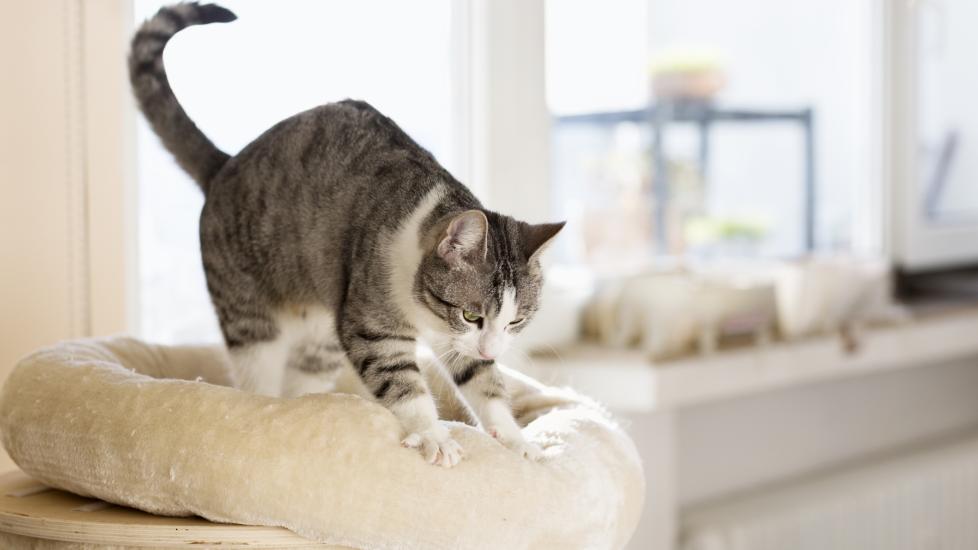Why Do Cats Knead?
Kneading, often referred to as “making biscuits,” is one of the behaviors domestic cats are best known for. It’s an instinctual behavior where the cat alternates pushing his paws into a soft surface, such as a blanket, several times in a row, similar to how a person would knead dough.
But why do cats knead like this? And why do some cats knead throughout their life, but others don’t continue the behavior past kittenhood? Here are some common theories.
Why Do Cats Knead Their Paws?
For many cats, kneading begins early. Kittens use a kneading action to stimulate milk production from their mother cat when nursing. Because nursing and being around a mother cat’s calming pheromones encourages a sense of contentment in young kittens, many cats will continue to knead into adulthood to create a similar sense of calm and relaxation.
But kneading isn’t just about kittenhood: Wild feline species will sometimes knead soft grasses and other bedding materials in their natural habitats as they prepare for rest. This form of kneading may also be practiced by domestic cats on their beds, blankets, and other favorite sleeping spots.
In addition, cats have scent glands between their toes. When they knead an object or a person, their scent is deposited onto that surface. This allows the cat to mark his territory, should other cats come sniffing around for resources to claim. Some experts also theorize that cats knead to stretch their muscles and relieve tension in their limbs.
Because nursing and being around a mother cat’s calming pheromones encourages a sense of contentment in young kittens, many cats will continue to knead into adulthood to create a similar sense of calm and relaxation.
Why Do Cats Knead Blankets?
Cats knead blankets and other soft objects in their environment for a few reasons:
- To create a sense of relaxation and relieve stress, as kneading soft objects may remind a cat of nursing. These cats may also suckle on a blanket while kneading to mimic nursing behavior.
- To tamp down their bedding material in preparation for sleep, a behavior also observed in wild cats.
- To claim blankets and other soft objects as their own by depositing their unique pheromones from the scent glands between their toes on these objects.
Why Do Cats Knead You?
Your cat may knead on you for some of same reasons he kneads on blankets and other soft objects: relaxation, stress relief, or to tamp down the material in their sleeping spot before settling in. For instance, you may see your cat knead on your stomach or lap before tucking their paws under themselves for a snooze.
When your cat kneads you, it can also be a sign of affection, since kneading is a behavior that he performed as a kitten with his mother. Kneading can thus convey a sense of comfort and security with you. Your cat may also knead to mark you with the pheromone glands in his paws, claiming you as his with his unique scent.
When your cat kneads you, it can also be a sign of affection, since kneading is a behavior that he performed as a kitten with his mother.
Should You Be Concerned About a Cat Kneading?
The action of kneading in cats causes the release of the pain-relieving, feel-good chemical dopamine in the brain. As such, increased or excessive kneading can be a sign that your cat is uncomfortable or anxious, and his kneading could be an attempt to soothe himself.
This release of dopamine also motivates your cat to continue kneading to receive additional bursts of the hormone, so excessive kneading can be a sign of a compulsive behavioral disorder. Cats experiencing soreness from an injury or arthritis may also knead to stretch their limbs and relieve muscle tension.
If you notice your cat is kneading more often than usual, consult with his primary veterinarian to address any underlying medical or behavioral concerns.
How To Stop a Cat From Kneading
Some cats may use their claws when kneading, which you might not appreciate if your cat is kneading on your skin or your furniture. While kneading is an instinctual behavior that cats should be allowed to express, you can redirect your cat’s biscuit-making to a more appropriate outlet.
Do: Talk To Your Vet
If your cat’s kneading is the result of a stress or an anxiety disorder, speak with your veterinarian about medications, supplements, and other products that may help him, such as Feliway® pheromone diffusers and Purina® Calming Care.
Similarly, if your cat’s kneading is the result of an underlying medical condition, speak with your veterinarian about how best to manage the illness. This may help correct excessive kneading more effectively.
Don’t: Punish Your Cat
Your cat should never be punished for kneading; do not yell, hit, or spray him with a squirt bottle. Punishing your cat in this manner may cause fear and anxiety, and it may not correct the kneading because he may resort to kneading when you are not around instead of stopping completely.
Do: Reward Him
Select appropriate items for your cat to knead, like a blanket on the couch. Reward and praise him consistently each time he uses his designated kneading spots.
Don’t: Declaw Your Cat
Cats should not be declawed to solve a kneading problem. Declawing is a painful procedure akin to removing the tips of your cat’s toes and causes lameness, biting, and permanent nerve damage.
Do: Trim Your Cat’s Claws
Keep your cat’s nails trimmed short to prevent injury to your skin and damage to your furniture from kneading. You can also place a blanket on your legs and stomach to provide a barrier between your skin and your cat’s claws if his kneading is uncomfortable for you. This allows you to preserve your bond with your cat while allowing him to perform a natural behavior.
Featured Image: SilviaJansesn/iStock / Getty Images Plus via Getty Images
